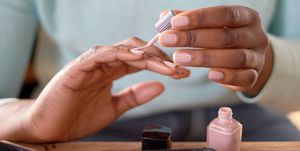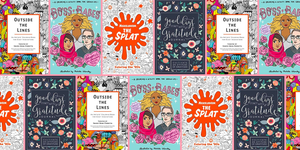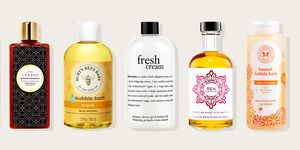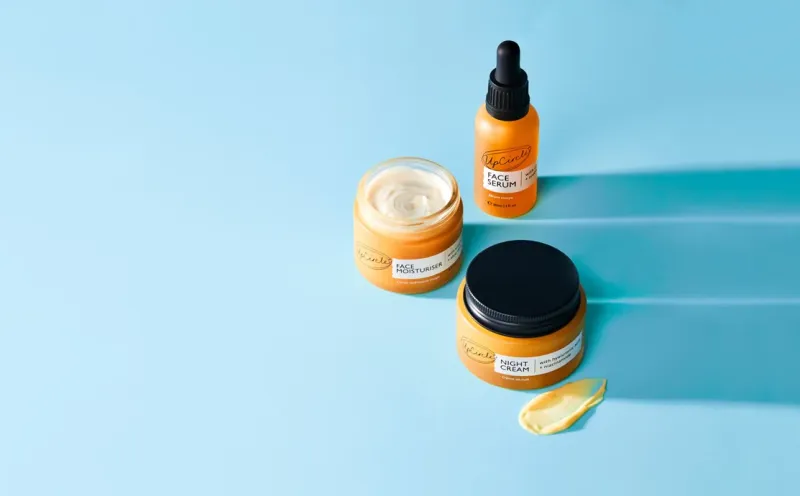These expert-approved tips will yield happy returns.
Spoiler alert: This past year has been challenging for nearly everyone—to say the least. So if you’re having more difficulty finding positivity and joy, you’re not alone. In fact, a recent survey from the University of Chicago found that happiness among Americans had fallen to a five-decade low.



The good news? While, yes, a good chunk of happiness is influenced by genetics and whether or not your basic needs are being met (like safety, shelter, and food), there’s also a lot you can do to get your joy back, even during hard, difficult times, says Sonja Lyubomirsky, PhD, professor of psychology at the University of California, Riverside. "You can absolutely improve your happiness level—as long as you’re willing to put the effort into it," she says. "If you constantly remind yourself to do little things, like look at the bright side of life, eventually those habits will become engrained."
Even better: By adding more joy to your daily routine, you may also enhance your overall well-being. “Happiness has two components,” Lyubomirsky says. “The first is life satisfaction, which is that sense that your life is going well. The second is the experience of frequent positive emotions, which include pride, curiosity, enthusiasm, tranquility, and joy.”
Here are the best expert-approved strategies for how to find more joy—in your work and your job, in your home, in your ordinary life, and, yes, even during the pandemic—starting today.
Strike up a conversation with friends, family members, even strangers.
Just in case you needed another excuse to invite your girlfriends over for wine and cheese (even if it's via a virtual happy hour) experts agree that we tend to be happier when we connect with other people. “Social interaction is the thing that most reliably increases people’s positive emotions, whether you're introverted or extroverted” says Elizabeth Dunn, PhD, professor of psychology at the University of British Columbia.



In fact, one Harvard study, which followed the same group of men for more than 80 years, found that having strong personal connections with other people was most directly correlated to overall happiness, better health, and more contentment. That's especially true if you surround yourself with happy people: Researchers behind a longitudinal analysis published in the BMJ found that a person is 15% more likely to be happy if a friend is happy—and that a person’s happiness can also influence—and be influenced by—their friends’ friends and even friends’ friends’ friends. (Need some help expanding your social circle? Here's some great advice for how to make new friends as an adult.)
While close friends might be the most obvious source of social connections, even seemingly trivial encounters with the random guy at your dog park or the cashier at your grocery store can boost your mood. In a 2014 study published in Social Psychological and Personality Science, Dunn and her colleague asked participants to pick up a beverage from a local coffee shop—half would get in and get out, and half would make friendly small talk with the barista. The researchers found that the people who were randomly assigned to have a real social interaction felt about 17% happier and more socially connected.
Make a joy list.
What brings you joy? The question seems simple enough, but when was the last time you really considered it? Thinking about what really makes you happy—spending time with friends, aspects of your work, or perhaps something else entirely—can help you make time for what truly matters. “It's often easiest to think about what might bring us joy when we remember times we've been joyful before,” says Laurie Santos, PhD, professor of psychology at Yale University. “Who were we with? What were we doing? How can we recreate those moments to experience joy again?”


You can even set up a digital picture frame loaded with photos from those joyful moments, suggests Michelle Gielan, author of Broadcasting Happiness: The Science of Igniting and Sustaining Positive Change. "A slideshow like that is a visual reminder of all the happiness we have experienced, and it cements those positive memories," she says. "

Need some inspiration? Consider Oprah’s list of what brings her joy. “Service, I gotta say, is my biggest reward and brings me enormous happiness,” she said in the July 2018 issue of O, the Oprah Magazine. “My own backyard, glowing in setting sunlight or fogged with mist from the Pacific. Every time I look at my yard, I get a thrill of delight. Same goes for delicious food from my garden, rolling in the grass with my dogs, sitting on the porch with friends, enjoying an evening cocktail, sharing a meal, talking books with people who appreciate good stories, LOLing (IRL!), taking a morning hike, luxuriating in a steamy bath with oils and candles, watching my South African daughter-girls grow into confident women, teaching what I've learned, and knowing I am loved.”
Give a little bit.
There’s a reason why the old adage “it’s better to give than to receive” has stood the test of time. It’s actually true, especially in regards to cultivating joy. When Dunn and her colleagues analyzed surveys from 200,000 adults globally, they found that in every major region of the world, people who gave money to charity were happier than those who did not—even after taking their own financial situations into account. That may be in part because giving to charity activates regions of the brain associated with pleasure, social connection, and trust, according to a 2006 study by the National Institutes of Health.
If you're on a tight budget, giving away just a little bit of money has the same effect on happiness as giving away a lot. In one study, Dunn and her colleagues handed envelopes of money to students at the University of British Columbia. The recipients were told they should spend the money—either $5 or $20—by the end of that day either on themselves or on others. “We found that people who spent the money on themselves that day weren’t happier that evening.” Dunn’s colleague, Michael Norton, told The Harvard Gazette. “But people who spent it on others were. The amount of money, $5 or $20, didn’t matter at all."
So, what is important? Where you give your money. “We’ve found that the benefits of giving spike when you actually have a window into the impact you’re making and when you feel a sense of connection to the people and the cause that you’re helping,” says Dunn. And if you're not interested (or can't) give financially, you can reap the same benefits by doing something nice for a person in need—even if that's just a phone call to check in.
Be even kinder.
Donating to meaningful organizations and causes isn’t the only do-good gesture that can increase your levels of joy. In a study published in the Review of General Psychology, Lyubomirsky and her colleagues asked college students to perform five acts of kindness per week over the course of six weeks. Some students were assigned to complete all five acts in one day, while others were asked to do all five acts spread over the week. “We found that when people carried out three to five acts of kindness a day, they experienced significant increases in happiness,” says Lyubomirsky. “And it didn’t have to be a big gesture. It could be almost anything, from giving a friend a ride to letting someone at the grocery store get in line ahead of you.”



In addition to the frequency with which you do kind acts, research has also indicated that varying the act itself is important. A 2005 study found that people who completed a variety of acts of kindness showed greater increases in happiness than those who performed the same activity over and over again. To help you get started, here are a few suggestions: surprise a neighbor with freshly-baked treats, compliment the first person you speak to each day, leave a thank you note for your mail carrier, run an errand for an extremely busy friend or family member, hold the elevator door when you see someone running towards it, pass along a great book you’ve just finished reading, and leave a generous tip for a pleasant waiter.
This content is imported from poll. You may be able to find the same content in another format, or you may be able to find more information, at their web site.
Add some color to your home—and world.
Can the colors, furnishings, and decorations in our home make us feel quantifiably happier? According to Ingrid Fetell Lee, a designer and author of Joyful, the answer is a resounding yes. More than a decade ago, Fetell Lee started asking complete strangers about the tangible things that brought them joy. To her surprise, some answers came up over and over again, including confetti, rainbows, treehouses, hot air balloons, googly eyes, kites, and clouds. “It was immediately clear that there was something about bright colors,” Fetell Lee says. “It seemed like they translated to joy.”
Scientific research agrees: A study of nearly 1,000 people across four countries found that those working in vibrant, colorful offices were not only more alert than those working in duller space, but they were also more joyful and friendly; another study found that bright colors—like pink and blue—are associated with positive emotions, while dark colors—like brown and black—are associated with negative emotions. That’s why Fetell Lee believes adding pops of color is one of the most effective ways to spark joy at home.


Not ready for a royal blue bedroom or a yellow kitchen? Fetell Lee has three bright ideas: Paint your front door with an eye-catching color, like coral—which is what Fetell Lee chose for her own house. “It’s the last thing you see when you leave, it’s the first thing you see when you get home, and it brings joy to the rest of the neighborhood,” she says. If you’re looking for an even more foolproof way to play with color, try replacing any white candles in your home with ones that come in happy hues, like yellow or turquoise. You can also paint the back of your closets or cabinets with bright colors or fun patterns. "It's an easy way to add little elements of surprise to your home," says Fetell Lee, who decorated her closet with bright yellow cabana stripes. "I can’t tell you how many times I've been surprised by those stripes—even though I’m the one that painted them!"
Make time for exercise—even if it's just 10 minutes.
Research shows that being at the top of your game physically, can also lead to being at the top of your game mentally. In 2018, a study published in the Journal of Happiness Studies found that people who worked out for as little as 10 minutes per week tended to be more cheerful than those who never exercise.



Even though the link between exercise and happiness does not appear to be activity specific, it's still important to discover the type of workout that works best for you, says Dunn. According to her research, people tend to underestimate the mood-boosting benefits of fitness because they focus disproportionately on the first bit of exercise, which can be generally aversive (think: when you start running and your muscles are still warming up). “Anything you can do to make the experience more enjoyable can help recalibrate your expectations—and help you more easily recognize the benefits of exercise,” she says.
Want to really step up your game? You might also consider activities that are done with other people, like taking a spinning class—after the pandemic, of course—or going on a run with a friend, Lyubomirsky suggests. “Not only do you get the benefits of exercising, but you also get the benefits of socializing,” she says. “That can result in an extra boost.”
This content is imported from poll. You may be able to find the same content in another format, or you may be able to find more information, at their web site.
Savor joyful moments, both big and small.
We often let ordinary joyful moments—like drinking your morning cup of coffee, inhaling the rich scent of a fresh candle, listening to birds singing outside your window—pass without acknowledging how pleasurable they actually are. But savoring, which is the attempt to fully feel and enjoy our positive experiences, is proven to increase happiness, according to Lyubomirsky. “It takes practice to really savor those moments—to not be distracted but be mindfully present for them, especially noticing how it feels in your body." says James Baraz, founding teacher of Spirit Rock Meditation Center and co-author of Awakening Joy: 10 Steps to Happiness. "It's one thing to know, I'm feeling good right now. But it's a whole other experience to know, This is what it feels like to feel good."



That not only creates positive feelings, but it also helps amplify them and makes them last longer. In one study published in The Journal of Positive Psychology, participants kept diaries for a month, recording the positive activities they participated in and how much they did or didn’t savor them. Those who reported high levels of savoring also maintained high levels of happiness no matter what the rest of the day brought, while those who reported low levels of savoring needed numerous positive events to be in a good mood.
Get houseplants.
You've probably noticed that plants are having a moment. Scroll through Instagram, and, chances are, you’ll come across pictures of rooms covered in leafy vines and tiny-but-mighty succulents. But the benefits of owning indoor plants go beyond interior decorating (though, yes, they are an easy, budget-friendly way to jazz up any room): One study published in the Journal of Physiological Anthropology found that touching and smelling indoor plants can reduce physiological and psychological stress, while another study published earlier this year found that even the mere sight of an indoor plant can reduce stress. Not to mention that they can also lower blood pressure, increase focus and concentration, and improve air quality, says Fetell Lee


Don’t exactly have a green thumb? Here are some of the most sturdy succulents, as well as some other plant varieties that are (nearly) impossible to kill. You can could also try The Sill's Plants for Beginners subscription service. Each month, the online shop will send you a low maintenance plant, a clay planter, and instructions for how to care for your new greenery.
Or, better yet...go outside.
A healthy dose of the great outdoors could make you healthier and happier. “Spending time in nature quiets the part of the brain that tends to brood and ruminate over any problems or worries,” says Fetell Lee. In addition to boosting mental health, a large body of research indicates that exploring your local park or walking through the woods can reduce stress, decrease blood pressure, lower the risk of heart disease and diabetes, as well as increase creativity, cognition, and life expectancy.
RELATED STORY

Plus, you don’t need to embark on a half-day hike for nature to work its magic on you. A 2019 study found that spending 120 minutes a week—or just over 17 minutes per day—strolling along a tree-lined creek or sitting by a lake greatly enhanced a person’s overall sense of well-being, while research published in the Journal of Positive Psychology found that spending just 5 minutes walking in nature will increase happiness. The bottom line? Any time spent outside is a step in the right direction. (If you’re unable to get outside, try looking at photos of natural environments, like images of a lush forest, which can produce similar effects, according to a 2015 study.)
Be grateful.
Gratitude isn’t just a concept we should visit over turkey, stuffing, and pumpkin pie. It’s a practice that’s been scientifically shown to increase your happiness. In a 2003 study published in the Journal of Personality and Social Psychology, participants were asked to write a few sentences each week—one group wrote about the things they were grateful for, another group wrote about the things that had displeased them, and a third wrote about the events that had affected them with no emphasis on them being positive or negative. After 10 weeks, researchers found that those who kept gratitude journals were happier and more optimistic. “Since joy is connected to appreciating particular things, counting your blessings is an easy way to notice the good things in your life in a way that can bring joy,” says Santos, who asks her students to keep a gratitude journal.


Ready to give thanks? Before bed, spend five to ten minutes writing down five things for which you are grateful—from having a job that constantly challenges you to coming home to a freshly-made bed—in a note on your phone, a daily calendar, or a special notebook. If you benefit from strength in numbers, take five minutes each night to share something you appreciated that day over a group email with friends or dinner with your family. “Gratitude with others multiplies the positive effect,” says Gielan. “Getting to know others by the small, meaningful, wonderful parts of their lives deepens relationships and sparks daily joy.”
Skip negative news first thing in the morning.
It doesn’t take a scientist to know that seeing or hearing negative news broadcasts can have an immediate effect on your stress level. But just how powerful is it? In a study conducted by Gielan, Arianna Huffington, and researchers at the Institute for Applied Positive Research, participants were asked to watch either three minutes of negative news before 10 a.m. or three minutes of positive, solutions-focused news. “When you’re exposed to just three minutes of negative news first thing in the morning, you have a 27 percent higher likelihood of reporting that you had a bad day six to eight hours later,” Gielan told The Washington Post. “We expected people would report being unhappier for the next few minutes after watching negative news. But we didn’t expect it to have such a lasting effect six to eight hours later.”
Here are a couple ways you can cut down on the negative noise: To avoid waking up to a flurry of breaking news alerts, shut off push notifications to your phone or email; instead of making breakfast while listening to talk radio or watching network news, tune into one of these motivational podcasts; and during during your commute to work, scroll through Instagram accounts dedicated to positive news (we recommend @tanksgoodnews and @goodnews_movement), rather than the day’s headlines.
If you have the means, invest in time-saving services.
Money can’t buy happiness, right? Well, according to some research, that depends on how you spend it. A study published in the Proceedings of the National Academy of Sciences found that when people spent money on time-saving services—paying for grocery delivery, hiring a housecleaner, using a lawn care company—they experienced a boost in happiness and overall life satisfaction. "Although buying time can serve as a buffer against the time pressures of daily life, few people are doing it even when they can afford it," Dunn said in a press release. "Lots of research has shown that people benefit from buying their way into pleasant experiences, but our research suggests people should also consider buying their way out of unpleasant experiences."
Then, spend those extra few minutes clearing your mind.
If you’re not sure how to make the most of your newfound free time, consider meditation, which has been shown to increase positive emotion, decrease stress and anxiety, improve your immune function, and enhance feelings of compassion. “We worry that being happy is selfish,” says Emma Seppälä, PhD, science director of the Stanford Center For Compassion and Altruism Research and Education. “But taking care of yourself not only boosts your own happiness, but it also results in more success in your career and relationships.” For help starting your meditation practice, check out these tips from Black Girl in Om's Lauren Ash, as well as our list of the best meditation apps out there right now.




